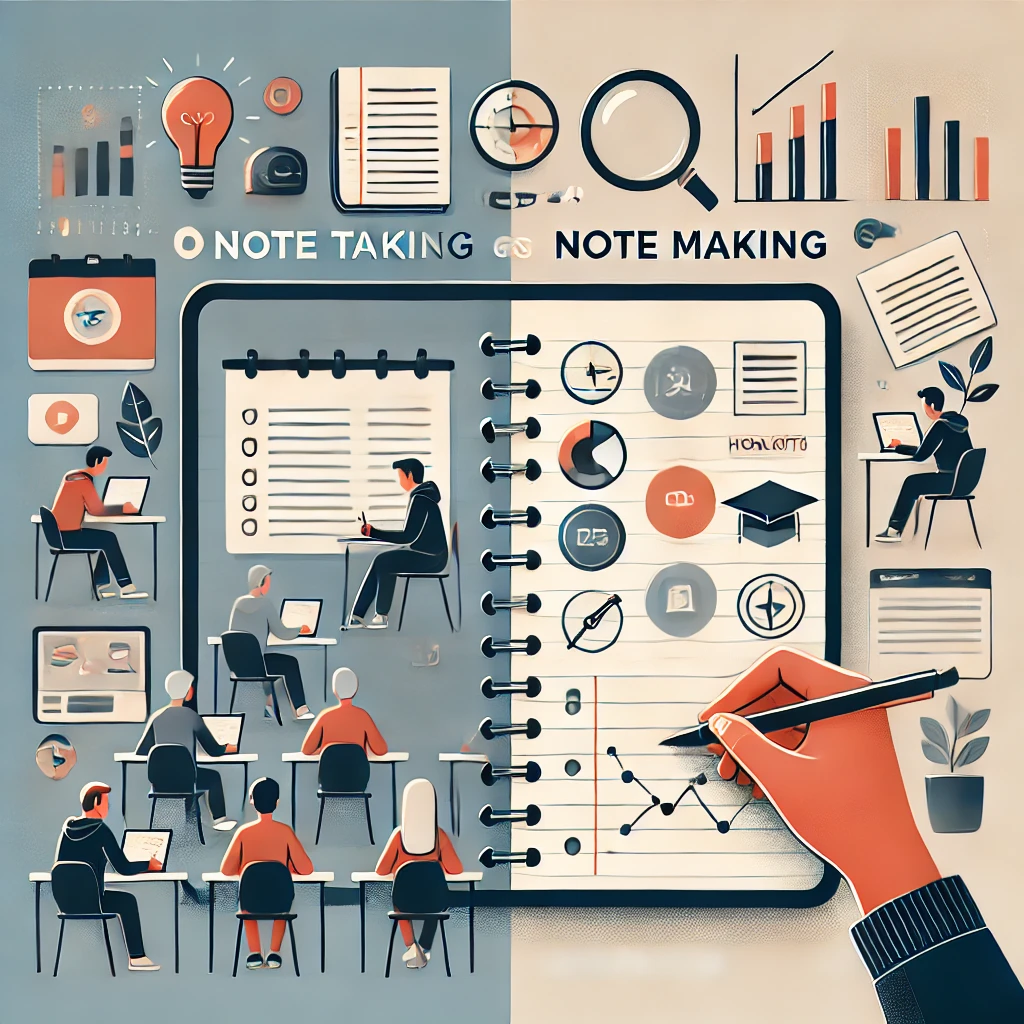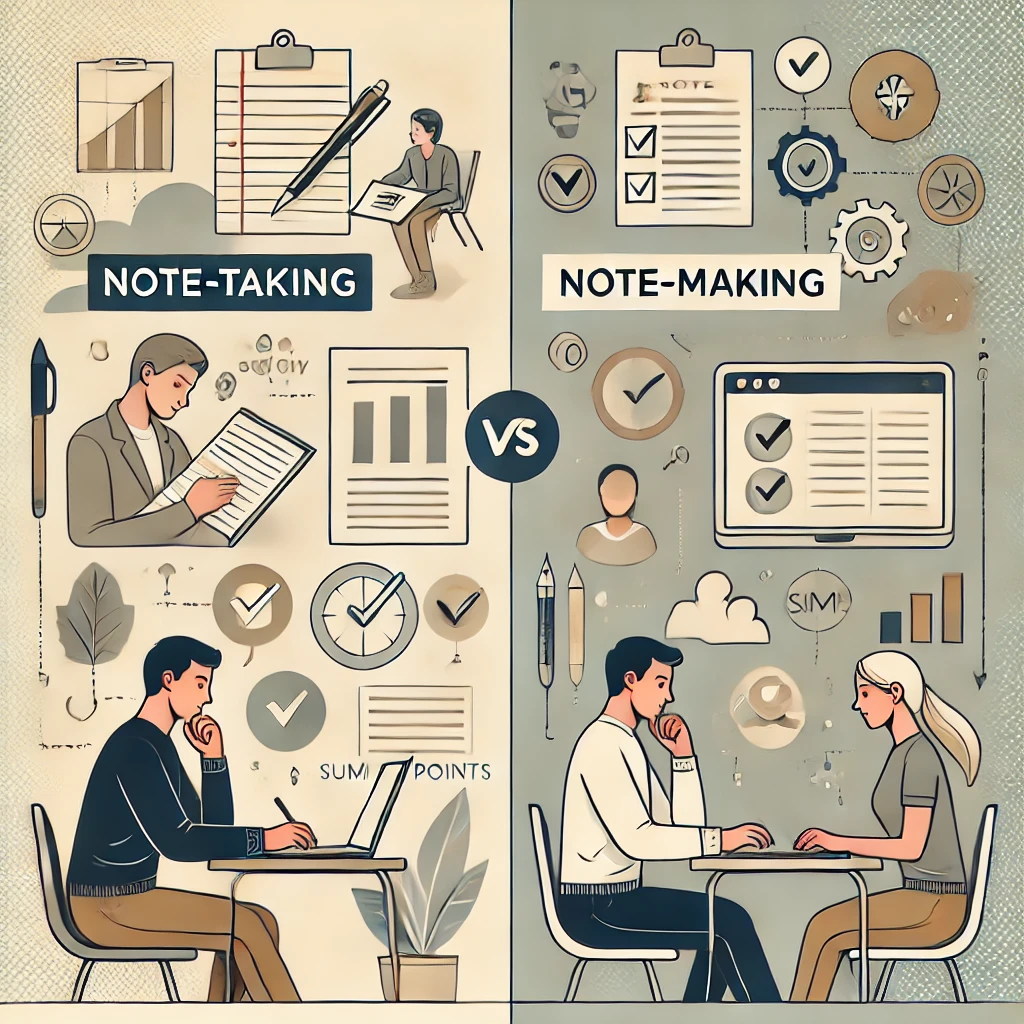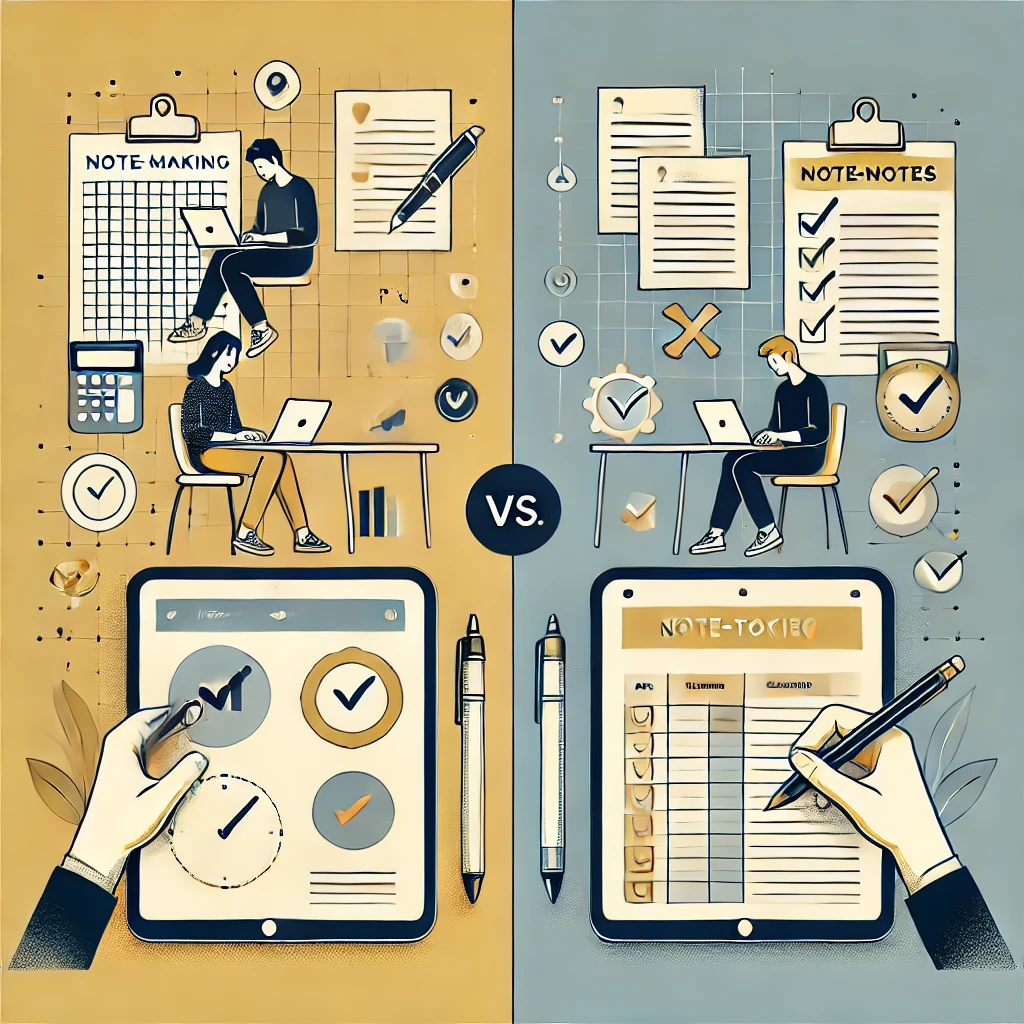Trying to master the art of information recording by exploring the difference between note making vs. note taking? Because you were writing hastily during an online meeting to catch critical points, being unable to focus on what matters most, right? I’ve been there.
Note taking refers to notes you take while listening to what others are saying for future reference. And note making refers to notes you make from texts.
Let’s examine these skills, reveal their similarities and differences, and learn essential techniques and strategies for information recording. Importantly, let’s see how a leading AI Note Taker can supercharge your productivity and retention and easily take your note skills to the next level.
Note Making vs. Note Taking? What Is the Difference?

What is the difference between note taking and note making? Yes, they have similar names, but their purposes are distinct. Note taking refers to recording information in real time, commonly used in classrooms, trials, boardrooms, and physician and clinicians’ offices.
In contrast, Edgar Wright described note making as a skill you use to rephrase information in your words, typically while reading. As for note taking, Wright described it as a skill used to capture content quickly for later reference, often while listening. However, these skills complement each other.
Wright is known for his contributions to educational and study techniques. In his 1962 book, Wright differentiated the two skills.
The history of note taking traces back to ancient times, with early forms of writing, such as stone marks. Ancient Greeks used the concept of hypomnema, meaning personal notes on essential subjects. Moreover, the early modern period in Europe saw a significant increase in documented notes.
Today, we witness the evolution of note taking from traditional methods to cutting-edge AI solutions, such as the AI Meeting Assistant. As a result, we capture and analyze information more effectively to improve collaboration and foster deeper learning.
Note Making vs. Note Taking: What Do You Mean by Note Taking?
What is the meaning of note taking? The latter refers to writing down what others say for future reference, often using the original author’s language. It’s a fast method of recording information.
Is note taking a skill? Yes, it’s an essential skill for studying and retaining information effectively. Moreover, it encompasses multitasking skills, such as quick thinking and attention concentration, to capture critical points during lectures or seminars.
You can take notes anytime and anywhere to underline ideas that stand out, whether during a:
- Course
- Meeting
- Presentation
- Lecture
- Reading a book
- Highlighting and annotating a book
And what is the purpose of note taking? It aims to capture and preserve what others have expressed, either verbatim or through your own words, so you learn and recall that information later. In contrast, note making generates new content based on your understanding.
Note Making vs. Note Taking: What Is Meant by Note Making?
Note making refers to creating notes and rewriting them in your own words so you can rephrase ideas to save them for future reference. Essentially, avoid unintentional plagiarism by using quotation marks for direct quotes or recording references before making notes.
You can make notes while reading texts, including books and journals.
Note making aims to express internal thoughts, ideas, and opinions through your voice. It explores connections between concepts and is like drawing or painting. In contrast, note taking captures external information.
Though note making is slower than note taking, it enhances understanding and information retention by using personal language. Moreover, note making generates and refines ideas, promotes intellectual engagement, and ensures deeper comprehension and information retention.
Note Making vs. Note Taking: Similarities

While discussing note making vs. note taking, you saw that the first one is more about internalizing and expressing ideas in your own words. The second one refers to recording information as it is presented. However, they have several similarities. Let’s jump right in:
- Active Listening and Engagement: You actively participate in reading or hearing to comprehend better and recall the information.
- Organization of Information: You organize the information systematically to study and reference the material later.
- Critical Thinking: You think critically about the content you’re engaging with to identify the essential points and ideas to record.
- Enhanced Memory Retention: Both improve memory retention as you listen or read the material attentively to select the key points to record.
- Improved Learning and Understanding: As you actively engage with the material, you better learn and digest it.
- Support Academic and Professional Activities: Both are essential in academic and professional settings as meetings, studies, and research require documenting and recalling critical information.
- Facilitated Review and Revision: Both provide a written record to refer to later, allowing you to review and revise the material quickly.
- Elevated Concentration and Focus: Both help maintain concentration and focus on the material, reducing the likelihood of distractions.
Note Making vs. Note Taking: Differences
Note making and note taking are distinct techniques with more than one difference. Let’s dig a little deeper:
- When You Should Record the Information: You take meeting notes in real time or you take notes during lectures and presentations where quick recording is necessary.
In contrast, you make notes in more reflective contexts, such as after reading a book, researching, or studying, where you have time to process and integrate information.
- Why You Record the Original Information: Note taking aims to capture information as it’s presented and record the main points for future reference.
Note taking aims to process and internalize information by rewriting it in one’s own words to deepen understanding. Also, it synthesizes information from various sources.
- How You Record the Original Information: Note taking lets you write down information verbatim or nearly verbatim as you hear or read it. It requires a focus on speed and accuracy to capture all essential details.
Note making lets you summarize and paraphrase information, requiring a focus on understanding and integrating information into your knowledge base.
- Language Used for Information Recording: Note taking directly reflects the original language of what you hear or read.
Note making reflects your language and interpretations by rephrasing the information to fit personal understanding and context.
- Engagement with the Material: Note taking is more passive than note making as it requires recording information without immediate processing.
In contrast, note making is more active as it requires critical thinking, reflection, and deeper engagement with the material.
- Speed of Recording: Note taking is faster since you should transcribe quickly without ignoring key details. In contrast, note making is slower as it requires thoughtful summarization and rephrasing of the content.
- Information Retention: When taking notes, you focus on recording the information quickly and often without much processing.
On the other hand, when making notes, you rephrase and summarize the information to reinforce the material in memory. As a result, it enhances retention and understanding better.
- Information Recording: Note taking means keeping a verbatim or near-verbatim record of the original information so you can later review and recall it.
In contrast, note making personalizes and synthesizes the original information, making it more meaningful and accessible to remember.
Note Making vs. Note Taking: What Are the Benefits?

Is note taking effective? Or how does note making help? Harvard professor Ann Blair said, “What is reading, after all? Even if you look introspectively, it’s hard to know what you’re taking away at any given time. But notes give us hope of getting close to an intellectual process.”
What are the benefits of note taking and note making? These two skills:
- Boost the speed of information processing
- Improve weak working memory
- Increase reading speed
- Improve spelling
- Facilitate the recording of essential information for later use
- Increase writing speed
- Improve the organization of written material to avoid muddled notes
- Make the material watched or heard more digestible
- Facilitate the summarization of information heard or watched
- Save the critical information for revision or future assignments
- Raise questions while you’re thinking about the material and recording it
How Are Not Making and Note Taking Useful?
Here are several study results showing how note taking and note making improve cognitive functions. These include attention, information processing speed, reasoning, problem-solving, planning, and multitasking.
Students who take lecture notes or text notes generally outperform those who don’t take them or merely listen to lectures or read texts. Specifically, note taking and revision boost comprehension, recall, and retention.
Note that revision positively affects your performance, particularly learning and test performance. Moreover, when you generate information and meaning while studying, you enjoy enhanced retention and learning.
Note Making vs. Note Taking with Krisp Meeting Assistant
The AI-powered Meeting Assistant from Krisp is a leader in Productivity Voice AI. Designed with efficiency in mind, Krisp transforms information chaos into productivity. If you’re exploring note making vs. note taking, use Krisp for both.
As TIME’s top pick for note-taking apps, Krisp doesn’t use an in-meeting bot and offers competitive pricing and excellent usability. What users like most about Krisp’s Notes is their exceptional 96% accuracy.
Imagine how Krisp could help during Shakespeare’s time when people were carrying “table books,” with specially treated erasable pages, to take notes and advertise themselves as note-takers. Unfortunately, only a few have survived from those table-book notes.
Benefits Offered by Krisp
Krisp is like your personal assistant. This AI Note Taker lets you generate detailed notes and listen simultaneously. Krisp provides the world’s only bot-free notes. So, how to make proper notes with Krisp? Also, how to take accurate notes
Automatically Transcribes Online Meetings
First, Krisp records your online meetings, classes, lectures, webinars, presentations, and discussions in real time, canceling background noise.
Krisp uses your computer’s microphone and speakers, so it doesn’t need to add a bot to avoid distracting attendees. The recording has best-in-class audio thanks to background voice, echo, and noise cancelation.
Offers Multilingual Transcriptions
Krisp’s Note Taking feature generates meticulous transcripts with stellar speaker recognition. So, if you’re off refilling your coffee while in an online meeting, be sure you won’t miss vital details.
An AI lecture note taker allows you to think about the big picture or focus on your lecture instead of wasting time on note-taking. Moreover, it offers synchronized playback with AI meeting transcriptions.
Summarizes Your Meetings and Lectures in Real Time
Krisp AI Note Taker transcribes and automatically summarizes your online meetings, discussions, or lectures. Then, you can save your notes with key points for future reference. Besides, you can review and share them with others later to empower accountability and collaboration.
Helps Individuals with Specific Learning Difficulties (SpLD)
Krisp best helps individuals with specific learning difficulties. For instance, students with dyslexia or dyspraxia have difficulty taking or making notes.
Dyslexia causes learning problems, making reading difficult. Dyspraxia also makes copying sounds, writing, moving, and proofreading difficult.
Helps Individuals with Hearing Problems
Individuals with hearing problems also have trouble taking notes. No worries. Krisp enables hard-of-hearing individuals to access meeting or lecture notes without missing anything important.
Lets You Write Out Major Questions
By focusing on what matters most and engaging in discussions or lectures, you can come up with critical questions or ideas. Moreover, Krisp’s Note Taking lets you see thought connections while listening. As a result, they can help you make more substantial decisions and enhance integration.
You Can Organize Information into Templates
You can organize Krisp’s Automated Summaries and Notes into a meeting notes template to help you take notes more intelligently, comprehensively, effortlessly, and productively. Moreover, it lets you save information updates, main decisions, and next steps, ensuring you never miss anything important.
Works Seamlessly Across Your Favorite Meeting Platforms
Whether you want to integrate AI Note Taker with Microsoft Teams, Zoom or Google Meet, Krisp integrates directly into your workflow. This ensures every meeting is transcribed and summarized automatically—without extra steps or added bots—so you can focus fully on the conversation while your notes are captured in the background.
Effective Note Making Tips
Studying note making vs. note taking isn’t enough. What about helpful note making tips?
- Connect Present with Past: Build your note making around past knowledge and projects.
- Focus on What Matters Most: Pick the most essential information heard or discussed.
- Find Connections: Draw mind maps by linking seemingly unrelated ideas to better memorization.
- Use Your Voice: Rephrase the original ideas to understand better, recall information, and avoid plagiarism.
- Make Your Notes Feel Alive: Revisit and review the ideas recorded. Add extra examples, questions, or details when revisiting your notes.
Effective Note Taking Tips
Discussing the issue of note making vs. note taking also means knowing how to take notes effectively:
- Use an AI-driven Note Taking App: Consider an AI tool with a Note Taker to automate and facilitate the process. Finding the best AI tool for interview note taking isn’t always straightforward, so we’ve put together a guide on the best AI note taking apps to help you compare different options and choose the one that works best for you
- Record the Most Essential While Scanning: For example, write “this article is about …” at the top of your notes. Then, continue taking notes.
- Write Down the Most Essential as You Move Forward: Record the main argument and add statement-supporting points.
- Be Clear: Avoid confusing thoughts. Include relevant quotes.
- Exclude Distractions: Take notes in a soundproof work or study environment that maximizes focus. Consider a noise cancellation app for online discussions or lectures.
- Include Visuals: For example, use colors, pictures, or diagrams to visualize the information. Because our hippocampus, the brain part that initiates memorization, loves visuals. As a result, you can memorize and recall notes easily.
- Organize the Information in a Template: Take notes in a structured way. A template can help organize your information better, facilitating memorization.
- Don’t Ignore Your Notes: Revisit your notes on the same day. Research reveals that review after a lecture boosts recall.
Methods or Techniques

Let me show note taking and note making methods that demonstrate effective techniques. This will help you organize information and highlight key points quickly.
Examples of Note Taking Methods or Techniques
Trying to take a meeting note? What about taking notes during a lecture? Whether you’re a seasoned professional or a beginner, note taking can be challenging if you don’t use specific techniques.
- Outlining Method: Structures notes hierarchically with main topics, subtopics, and details via indents and bullet points. Logical organization facilitates review.
- Cornell Method: Divides the page into a narrow left column for keywords and questions, a right column for detailed notes, and a bottom section for summaries. These sections improve learning.
- Sentence or List Method: Uses a separate line to write each new information piece. Such list of sentences is quick and easy but needs more organization.
- Flow-based Method: Captures information non-linearly and connectedly through arrows and diagrams. It emphasizes the relationships between concepts.
- Table Method: Categorizes information into columns and rows for comparison and contrast. It’s ideal for organizing a lot of data.
- Charting Method: Uses a table format to categorize notes. It helps compare information quickly and is ideal for distinct categories, including timelines.
- Mapping Method: Visually organizes information into a mind map with branches connecting related topics. It helps visualize connections and hierarchies between concepts.
- Rapid Logging Method: Uses symbols to categorize tasks, events, and notes. It’s flexible and efficient for daily planning.
- Matrix Notes: Organize information into a grid format, comparing and contrasting different information pieces across various categories. It’s ideal for complex subjects requiring detailed comparisons.
- Guided Notes: These teacher-prepared handouts with structured blanks help students fill in during lectures. They help note-takers focus on critical points and capture essential information.
Examples of Note Making Methods or Techniques
Still figuring out which one to choose, note making vs note taking? Here are methods to help you know how to make proper notes:
- Linear Method: Makes notes in a sequential, linear format, often using bullet points and headings. It’s straightforward to review but lacks details.
- Zettelkasten Method: Uses index cards or digital equivalents, each linked to the others. Thus, it creates a network of related concepts to enhance deep learning and retrieval.
- Digital Gardening is a symbolic approach in which ideas are “planted” as seeds, “grown” through continuous learning, and “harvested” as new insights. It’s a long-term, visual, and creative method.
- Mind Mapping: Visually represents information around a central concept, with branches connecting related ideas. This type is based on interconnected topics and enhances creativity, memory, and understanding.
- Survey, Question, Read, Recite, and Review Method: Offers a structured process for actively engaging with the material. It promotes deeper comprehension and retention.
- Flashcards: Creates concise notes with questions on one side and answers on the other. It’s effective for memorization and quick review of key concepts and terms.
- Concept Mapping: Creates diagrams showing relationships between different concepts. It helps understand complex information and visualize connections.
- Annotation: Adds notes, comments, and highlights to a text. It enhances critical reading, understanding key points, and engaging deeply with the material.
- Evergreen Notes: These are long-term, reusable notes continuously updated and connected to others. They form a network of valuable knowledge for ongoing learning and idea development.
- Split-Page Method: This method divides the page into two columns. One is for main notes, and the other is for questions, summaries, or reflections. It encourages active engagement and review.
Note Taking Template
When deciding on note making vs. note taking, you should also know how to organize your key takeaways into a template. Whether you need a lecture or a meeting minutes template, the latter will help you record organized and effective notes.
For example, let’s look at the Cornell Method template:
Course/Subject: [Enter Course/Subject Name]
Date: [Enter Date]
Keywords/Questions Notes
[Key Concept 1] [Detailed notes on the concept, including definitions, explanations, and examples]
[Key Concept 2] [Detailed notes on the concept, including definitions, explanations, and examples]
[Question 1 about the lecture/reading] [Answer to the question, or space to write the answer later]
[Key Concept 3] [Detailed notes on the concept, including definitions, explanations, and examples]
[Question 2 about the lecture/reading] [Answer to the question, or space to write the answer later]
Final Words
Exploring the ins and outs of note making vs. note taking reveals how these essential skills can boost your productivity and learning. Precisely, note taking quickly captures information as it’s presented, often using the speaker’s language. It records vital information during lectures, meetings, or reading to refer back to later.
Note making rewrites information in your own words to better understand and retain it. It processes and synthesizes content from various sources, encouraging deeper engagement and critical thinking.
Krisp AI Meeting Assistant helps you capture, transcribe, and summarize meetings effortlessly. Krisp’s Note Taking feature improves productivity and efficiency and never lets you miss a critical point.
Frequently Asked Questions
- Linear Method: Writing notes sequentially in a straightforward, bullet-point format.
- Zettelkasten Method: Using index cards to record and link individual ideas for deeper understanding.
- Digital Gardening: Continuously updating and connecting notes in a non-linear, visual format.
- Mind Mapping: Creating visual diagrams connecting ideas around a central concept.
- Concept Mapping: Drawing connections between related ideas to understand relationships and hierarchies.






